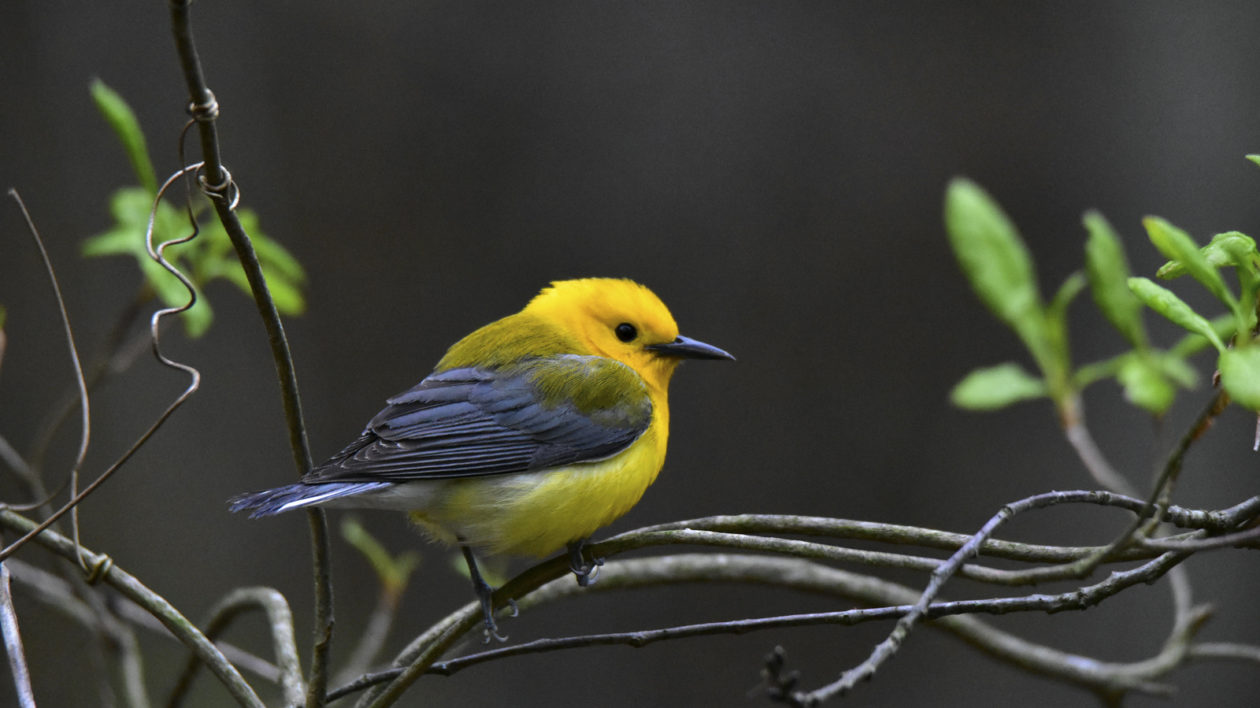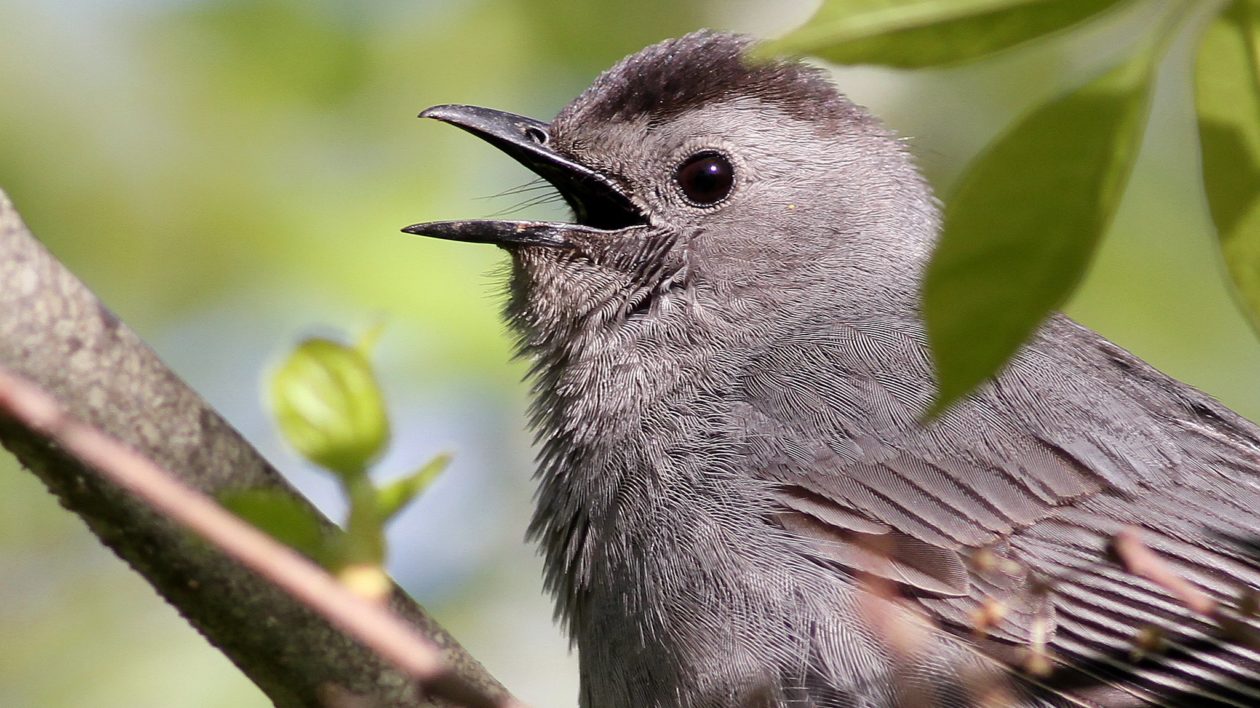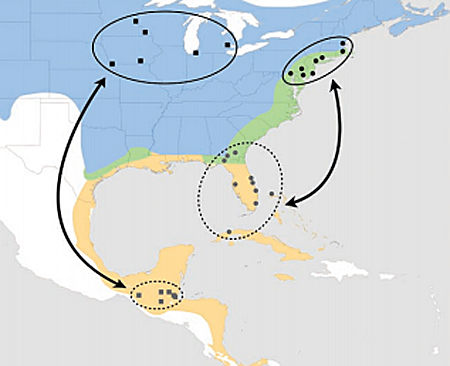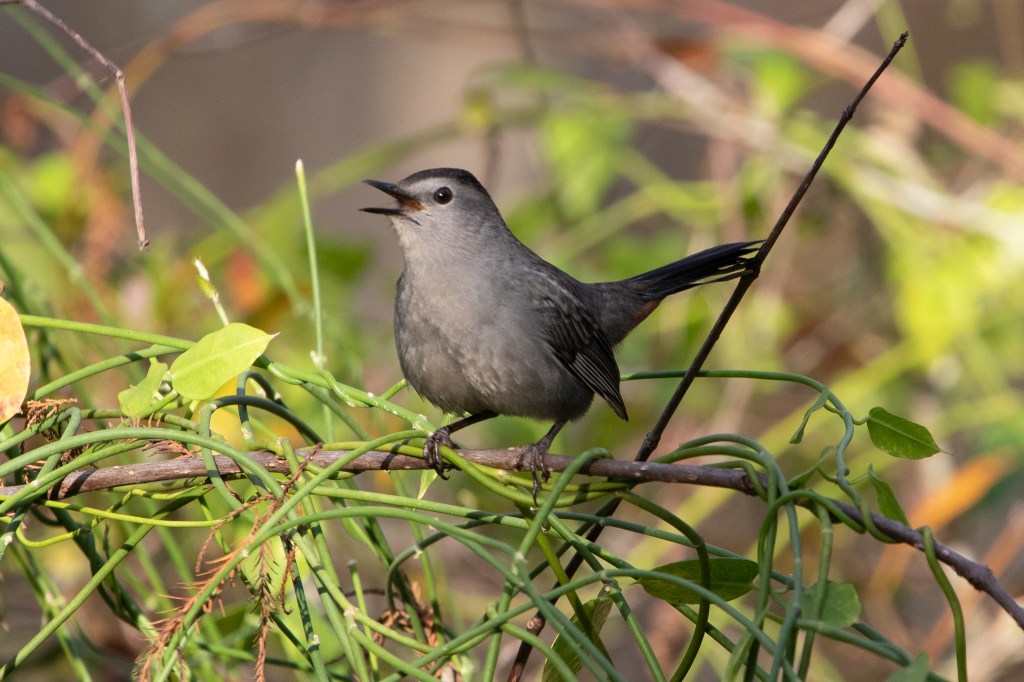Consider the gray catbird: the tropical long-distance migrant that may well be nesting in your backyard this summer.
Gray catbirds are common, so you may not pay them much attention. But look into the research, and you’ll find that this backyard bird is full of surprises. Let’s take a closer look.
As I write this, a gray catbird is singing in my backyard.
It arrived here in New Jersey several weeks ago and may already be building a nest with its mate somewhere in the neighborhood.
I am wondering where my catbird spent its winter – and whether this is the very same catbird that was in my yard last summer. Research on catbirds can help answer these questions.
Every spring, dozens of species of migrant songbirds make their way north from the tropics to settle into nesting habitats across North America. Indeed, half of all North American birds spend their winters south of the U.S. border – from Mexico through South America.
Most of these species are habitat specialists and we might see them in our backyards only briefly during migration as they make their way to more remote places.

The gray catbird, on the other hand, is a migrant from the tropics that is quite happy to claim a breeding territory in a wide variety of shrubby habitats, including suburban backyards.
The catbird singing in your backyard this spring is likely the same one that was there last year. Individual catbirds (and numerous other species) return to the same habitat patch to nest year after year, as long as they are fortunate enough to survive from one season to the next. Studies have shown a roughly 60 percent annual survival rate for catbirds.
If your backyard catbird has a lucky streak, you could see the same bird coming back for many seasons. The longevity record for a catbird is 17 years, 11 months.
This nearly 18-year-old bird was caught and banded as a young of the year in Maryland and miraculously encountered again by banders those many years later in New Jersey.
Banding can confirm the age of birds and also confirm that the bird in your backyard this year is the same one that was there last year.
Participants in programs like Neighborhood Nestwatch can observe their backyard catbirds wearing unique combinations of colored leg bands. These identify each bird as an individual and can be viewed with binoculars. For this project, researchers and participants alike can make observations on the identity and longevity of their catbirds.
Catbirds nest in 46 of the lower 48 United States and across southern Canada. They spend the winter across an equally broad area. A proportion stay in the U.S., where they primarily occupy the Gulf Coast and Florida. Some hearty individuals hang in there as far north as New Jersey.

Others go further south to the tropics – to the forests of Mexico, the Caribbean and Central America. There, they share the woods with jaguar, tapir, fer-de-lance and toucans.
Catbirds return to the same site on the wintering grounds every year as well. Your backyard catbird might spend the winter in the shadow of Mayan ruins in Guatemala or perhaps in the Florida Everglades.

We can make an educated guess on where your backyard catbirds spend the winter thanks to a recent analysis of banding records along with the use of tracking devices.
What this work tells us is that if a catbird breeds in the upper Midwest, it is more likely to be spending the winter in Central America. If it nests in the mid-Atlantic and New England, your catbird is likely spending the winter in Florida or the Caribbean.
As more studies like this one are carried out, we will have a further refined picture of “migratory connectivity” between nesting and winter sites. And we will be able to make even better guesses about where our backyard catbird might be next winter.
“A Few Raisins Give Him the Greatest Delight”
If you want to kick things up a notch for your backyard catbirds this summer, in addition to providing water, you can also offer them fruit.
As the poet Mary Oliver observes in her poem “Catbird”: “But a few raisins give him the greatest delight.”
One of the pleasures of a birding holiday in the tropics is watching birds at fruit feeders. After hours of seeking difficult-to-see skulking birds of the undergrowth and fast-flitting birds of the high tree tops, birding respite can be found at lodges and cafes that maintain fruit feeders for birds. Dozens of species of brightly colored birds come into easy view to eat banana, papaya and citrus at close range.
Catbirds bring a bit of this culture back with them from the tropics and are among the few birds at our northern latitudes that will readily eat soaked raisins, sliced orange and even grape jelly.
Back to my well-fed catbird. Is he the same bird as last year? Without banding him, I can’t know for sure. But I do know that he will do everything within his power to return here.

And return from where?
Maybe it is time to combine science with imagination. The science tells me that he wintered somewhere in Florida or the Caribbean.
But for better spatial resolution, my imagination is saying the Zapata Swamp of Cuba. Listen to what he sounds like there (in the audio file) … and then listen for the catbird in your yard!




What a great piece. Spotted one in my yard this morning in Boston and didn’t know anything about the bird. Hope he returns & will put out some raisins.
5/11/16 8:12 am
I hear a shreik outside my window. One minute later my cat enters with a mouthful of adult Catbird, which he deposits at my feet. I quickly/gently snatch the bird from him, offering my bedroom as a hiding place. It goes straight behind the nightstand – alive, but scared.
It’s an hour now, and I haven’t seen him fly yet. He runs on the floor and hides in corners.
If he can fly, I will summarily release him to go about his morning agenda. I put birdseed and water on the floor near him. Should I leave him a raisin or orange slice, too?
Rachel
rucheili60@gmail.com
Hi Rachel, This information at Cornell lists some of the fruits that catbirds are known to eat including cherries, grapes, blackberries and strawberries: https://www.allaboutbirds.org/guide/Gray_Catbird/lifehistory
I had catbirds that returned every summer to my 1/2 acre with a creek in Toledo Oh. They ate the grape jelly that I put out for the Baltimore Orioles. Always interesting to watch them and enjoyed listening to their cat like sounds. Great article, thanks!!
…very nice interesting commentaries..
I would like to ”add” something..about ”my catbirds ” !..I live in Milford NH and for many years I did try
to entice the bluebird so called of happiness ….I did keep a special feeder only with dry meal worms ..finally I do have them , beautiful !..but..the dry meal worms are pretty expensive !..the feeder is right outside of my window..and the ”blue-s ” are coming..but so did the cat birds !..soo..what to do with them ?!.. they do like bred , I did notice..and also they do like peanut butter..when in the spring I did make a plate for Baltimore orioles..( they spent very short time in my yard..this year I mean )..I did see the catbird eating with grate pleasure peanut butter..than..not too far from the blue birds feeder with meal worms..I hanged a feeder with peanut butter..so..that’s was the ”convention ” !..I give you peanut butter, you do not get the meal worms !..it worked !..you could see them , many times at the same time..one , the blue , near the window having the mealworms and the”cat”..at the other feeder , having the peanut butter..funny, in the last month they are a lot of young red belly wood peckers coming to have peanut butter !..and the cat birds..yes, they are clever and friendly , I am on the porch working with their feeders…they are less than 3-4 feet from me..waiting..now I do see the new generations of both, the bluebirds and the catbirds..I would say..many years ago..when I did hear a cat bird for the first time..I did believe it’s a lost kitten !( we do not have them in East Europe, the place I’m from..)
..I’m curious when they leave..I mean , migrate…in the last 2-3 days..I did not see them as many times as they use to show up..
We love the catbirds around our home in Brewster on Cape Cod. They are also very smart. They are the only birds that discover the holes in our net over our raspberry patch and hop in and out along the ground and next to the shed without a problem. Plus when I am picking, one sits on the pole supporting the net and yells at me!- probably saying get away from my berries!
I am SURE that our Catbirds are the same ones each year, or their progeny. How?! Because the two pairs each nest very near to our elderberry bushes (on either side of the house/yard) and guard against all other (catbird) comers and most other species as well! There is NO way a new yard catbird can find an elderberry bush before it flowers, so I’m pretty darn sure that our lovely singers who serenade us each summer are regulars. They are over the moon with singing and activity when the berries are ripe!!
humorist h allan smith quoted expression, #in the catbird seat#, meaning ideally situated—i thought it referred to a cat ready to pounce, so today i learned something…but the original understanding seems more relevant, anyway.
A very interesting article about a really neat bird. I’m fascinated to think the catbirds around my place near Philadelphia don’t mix with my family’s catbirds in the midwest in their wintering grounds.
I’ve noticed this summer there seem to be a lot more catbirds than I’ve ever seen before; I can’t seem to go anywhere, even in the city, without seeing and hearing one. Are their populations on the increase?
I have a very friendly, inquisitive Catbird that usually accompanies me in the garden when I’m working in it. As soon as I start planting or ripping up weeds, he’ll perch close by and call to let me know he’s there watching. Once I’ve ripped up an area of weeds, he’ll jump down and start routing around the area for insects, even if I’m not far away in a new spot. My garden buddy cracks me up, and I love the company!
Exactly the relationship I have with our catbird. When he follows me so closely in the vegetable garden, he sings with the softest, sweetest little chortle, as if he’s letting me know he’s right there with me and could I please share any “finds” with him. Often he doesn’t wait for handouts but hops right in to the area I’m weeding or planting. Love, love, love his company.
I had a row of blueberries which the cat birds loved. They nested in a holly tree outside of my kitchen window . It was neat to hear their call like a cat meowing softly in addition to their singing.
So the catbirds that loved my blueberry patch wintered in Florida and the Caribbean!
I live on a lake in Northern NJ and have catbirds every year. But, they are so secretive that I have never found a nest. I cultivate blueberry bushes as they love the berries, and I love to watch them feeding.
Years ago, catbirds were common in my family’s back yard. I have been living in my house for over 20 years and have never seen one in my neighborhood. There are plenty of mockingbirds which, I believe, enjoy the same diet. Why are the catbirds strangers in my neighborhood (Cincinnati, OH)?
Catbirds and Mockingbirds compete for the same food and habitat, so it’s unusual to have both in the same location. Since we moved, we have Catbirds but no Mockingbirds. Our previous home was just the opposite.
A robin started building a nest in our garage (!) 10 days ago on top of the garage door opener mechanism. Typical looking start for a robins nest. Two days later we had a very atypical completed nest with a catbird sitting in it–robin base, catbird crown! Catbird had eminent domain for 2 days and was then usurped by the robin. A lot of chasing and pursuing is going on in the yard. No eggs in the nest yet. I must add that we have a very bird friendly large suburban CT yard and have already observed first broods of robins and catbirds this year, reared in appropriate nests and locales. What is going on here?
I just started a group on Facebook called Catbird Lovers! I haven’t added anything yet but please join so we can share more stories with each other. Mew!